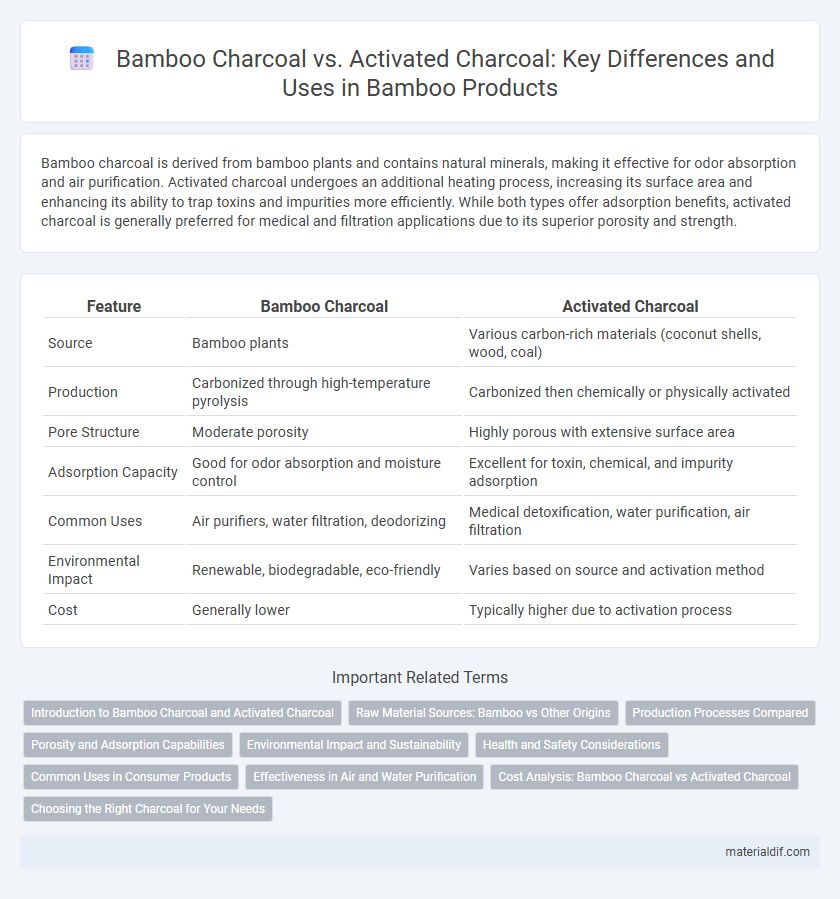Bamboo charcoal is derived from bamboo plants and contains natural minerals, making it effective for odor absorption and air purification. Activated charcoal undergoes an additional heating process, increasing its surface area and enhancing its ability to trap toxins and impurities more efficiently. While both types offer adsorption benefits, activated charcoal is generally preferred for medical and filtration applications due to its superior porosity and strength.
Table of Comparison
| Feature | Bamboo Charcoal | Activated Charcoal |
|---|---|---|
| Source | Bamboo plants | Various carbon-rich materials (coconut shells, wood, coal) |
| Production | Carbonized through high-temperature pyrolysis | Carbonized then chemically or physically activated |
| Pore Structure | Moderate porosity | Highly porous with extensive surface area |
| Adsorption Capacity | Good for odor absorption and moisture control | Excellent for toxin, chemical, and impurity adsorption |
| Common Uses | Air purifiers, water filtration, deodorizing | Medical detoxification, water purification, air filtration |
| Environmental Impact | Renewable, biodegradable, eco-friendly | Varies based on source and activation method |
| Cost | Generally lower | Typically higher due to activation process |
Introduction to Bamboo Charcoal and Activated Charcoal
Bamboo charcoal is produced by heating bamboo at high temperatures in the absence of oxygen, resulting in a porous material known for its natural adsorption properties and eco-friendly qualities. Activated charcoal, however, undergoes an additional activation process, usually with steam or chemicals, to increase its surface area and enhance its ability to trap toxins and impurities. Both charcoal types are widely used in air and water purification, but activated charcoal offers superior adsorption efficiency due to its increased porosity.
Raw Material Sources: Bamboo vs Other Origins
Bamboo charcoal is derived specifically from bamboo plants, offering a sustainable and fast-growing raw material source compared to traditional activated charcoal, which is typically produced from hardwood, coconut shells, or peat. The unique cellular structure of bamboo allows bamboo charcoal to have higher porosity and absorption capabilities. Sourcing charcoal from bamboo supports environmental conservation due to bamboo's rapid renewability and lower impact on forest ecosystems compared to other raw materials.
Production Processes Compared
Bamboo charcoal is produced by carbonizing bamboo at high temperatures in a low-oxygen environment, retaining its natural porous structure ideal for air and water purification. Activated charcoal undergoes a further activation process involving steam or chemicals at even higher temperatures, greatly increasing its surface area and adsorption capacity. The production of bamboo charcoal is more eco-friendly and sustainable, while activated charcoal offers superior purifying efficiency due to its enhanced porosity.
Porosity and Adsorption Capabilities
Bamboo charcoal exhibits a highly porous structure, characterized by a large surface area that enhances its adsorption capabilities for moisture and odors. Activated charcoal, often derived from bamboo or other sources, undergoes a specialized activation process that significantly increases its porosity and effectiveness in trapping toxins and impurities. This increased porosity in activated charcoal makes it superior in adsorbing gases, chemicals, and heavy metals compared to regular bamboo charcoal.
Environmental Impact and Sustainability
Bamboo charcoal is produced through pyrolysis of bamboo biomass, generating fewer greenhouse gas emissions compared to the chemical activation process of activated charcoal, which often relies on non-renewable resources. Bamboo's rapid growth rate and carbon sequestration capabilities enhance its sustainability, making bamboo charcoal a greener alternative with a smaller ecological footprint. Activated charcoal offers higher adsorption efficiency but often entails more energy-intensive production, intensifying environmental impacts relative to renewable bamboo charcoal production.
Health and Safety Considerations
Bamboo charcoal is prized for its natural adsorption properties and lower chemical processing, making it a safer choice for air purification and skin applications compared to activated charcoal, which undergoes intense activation with harsh chemicals. Health considerations highlight bamboo charcoal's lower risk of irritation and toxicity, while activated charcoal's finer pores may trap more contaminants but can cause respiratory issues if inhaled in powder form. Safety protocols recommend using bamboo charcoal products for gentle detoxification and indoor odor control, while activated charcoal requires careful handling to avoid lung irritation and requires medical supervision for internal use.
Common Uses in Consumer Products
Bamboo charcoal is commonly used in air purifiers, water filters, and skincare products due to its natural deodorizing and moisture-absorbing properties. Activated charcoal, often derived from coconut shells or wood, is widely utilized in medical treatments, beauty products, and oral care for its superior adsorption capacity to remove toxins and impurities. Both charcoals are incorporated into consumer products, but bamboo charcoal emphasizes eco-friendly odor control and humidity regulation, while activated charcoal focuses on deep-cleaning and detoxification benefits.
Effectiveness in Air and Water Purification
Bamboo charcoal excels in air purification due to its high porosity and natural antibacterial properties, effectively absorbing odors, moisture, and pollutants. Activated charcoal, often made from various carbon-rich materials, undergoes chemical activation to significantly increase its surface area, making it more efficient for water purification by trapping finer contaminants and toxins. Both types provide strong purification capabilities, but bamboo charcoal is preferred for air quality improvement, while activated charcoal is more effective in water filtration systems.
Cost Analysis: Bamboo Charcoal vs Activated Charcoal
Bamboo charcoal generally presents a lower production cost compared to activated charcoal due to its natural and less intensive processing requirements. Activated charcoal undergoes additional activation steps involving heat or chemicals, increasing its manufacturing expenses and market price. The cost-efficiency of bamboo charcoal makes it a competitive alternative for applications such as air purification, water filtration, and odor control.
Choosing the Right Charcoal for Your Needs
Bamboo charcoal offers a natural, eco-friendly option with superior absorption for moisture and odors, making it ideal for air purification and deodorizing spaces. Activated charcoal, processed at higher temperatures with added activation, provides a higher surface area perfect for medical uses like toxin removal and water filtration. Selecting the right charcoal depends on whether you prioritize sustainability and odor control or require enhanced filtration and detoxification properties.
Bamboo charcoal vs Activated charcoal Infographic

 materialdif.com
materialdif.com